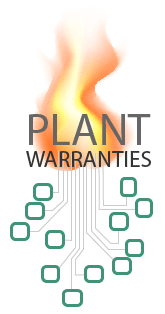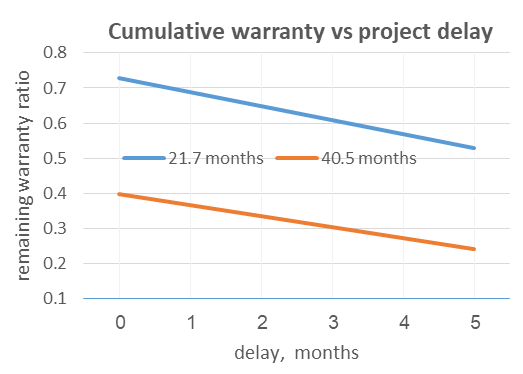
In 2018 ACCIONA, the leading desalination company, had been awarded the 210 MLD plant. It was the EPC contract, plus a one-year warranty, to be completed in two years.
Warranty negotiation is probably the hardest part of any project after its price. The reason lies in the following clause of the standard warranty conditions regarding the warranty effective date.
The warranty period starts at either product commissioning or six (6) months after shipment, whichever comes first. Where the site performance test is requested, the warranty period shall commence upon successful completion of the test.
As the plant acceptance test takes place long after the equipment commissioning, original warranties are half-spent without producing a single drop of water.
The rate of the warranties burning may be characterized by change in the cumulative warranty - the sum of all warranty durations. It is above 20,000 months.
As follows from the graph below, after handover of big projects (with the execution time of about 40 months) only 40% of cumulative warranty remains.

Every month of the project delay burns about 500-900 months of cumulative warranty.
In one-year warranty projects, EPC contractor has to handle not only extra expenses, but a constant flux of warranty claims. It shall enter into totally new business niche - the warranty management. It becomes critical in projects with 2-year warranty (Adelaide plant, Australia).
How to mitigate the warranty burning rate? Start from warranty negotiation. For bespoke equipment, the warranty wraps around the customer technical requirements. Warranty adds the time dimension to requirements; it makes them durable. Hence, warranty is an answer to the customer request, not the vendor gift.
Table below summarizes typical basic and best-of-the-class warranties for some equipment classes. The best are all conditional, tied to Original Equipment Manufacturer (OEM) instructions.
Table 1 Industrial products typical warranties| Class | Basic | Best/Extended |
|---|---|---|
| Pump | 24 | 60 |
| Pump mechanical seal | 12 | 24 |
| Pump coupling | 12 | 24 |
| Micron filters | 12 | 60 |
| FRP tanks | 12 | 36-120 |
| Polyethylene tanks | 12 | 36 |
| SS316 steel tanks | 12 | 120 |
| Duplex steel tanks | 60 | 300 |
| Valves | 12 | 24 |
| Valves (clean non-corrosive service) | 12 | 48-60 |
| Instrumentation | 12 | 24 |
| Electromagnetic flowmeters | 12 | 36-120 |
| Transformers | 12 | 96 |
| Circuit breakers | 24 | 120 |
| Enclosures | 12 | 60 |
| Wiring accessories | 12 | 120 |
| Motors | 18 | 36-60 |
| Inverters | 12 | 36 |
The main obstacle in negotiating better warranties is the OEM distrust to the EPC contructor. For example, ABB hints at it as follows.
Although the function is guaranteed for three years with the warranty, ABB expects the motor to last much longer than this. Given the correct maintenance, 10-20 years of reliable service can reasonably be expected. However, an important part of regular maintenance is bearing re-lubrication and replacement at the prescribed intervals. The warranty period has deliberately been kept shorter than the first bearing replacement interval to avoid any confusion.
This distrust is often amplified by OEMs using motors in their products. For example, one reputable pump manufacturer slashes down the motor warranty from 3 years to 1.5 explaining it by confusion about the number of the pump startups per day.
In other words, the road to better warranties is paved with transparencies in the product selection, installation, usage and maintenance. This road's starting point is the following clause in the warranty agreement.
The vendor shall be provided with access to O&M and data acquisition databases related to the warranted product. The O&M database shall track all the preventive maintenance activities scheduled in the preventive maintenance plant submitted with the product. The data acquisition database shall contain the time series of values covered by the Performance Warranty (if included in Extended Warranties).
To handle warranty-related interactions between OEM, EPC contractor and the plant operator, the warranty management framework is needed. Its prototype developed by crenger.com focuses on the following tasks
- Warranty agreement auto-generation
- Warranty auto-activation
- Warranty expiration tracking
- Warranty claim form auto-generation
- Warranty-related performance data definition
The first task deals with different types of extended warranties - performance, structural, corrosion, prorated, etc. - mapped to specific equipment classes. Auto-activation alerts OEM on the equipment status change. Expiration tracking reminds the EPC contractor of the spare parts purchase. Claim forms may be easily generated from automated bookkeeping of maintenance activities. The final task is added to the project data acquisition system discussed previously.
To rate the warranties, two indicators have been introduced. The first is the ratio of the spare parts stock price to the validity duration. It shows how costly is the warranty. The second indicator is the ratio of Minimum Time Between Failures (MTBF) to the validity duration. MTBF is widely used for the plant reliability prediction. For best-of-the-class warranties it is 1.5 – 2.0. The range of 2.0 – 3.5 is considered satisfactory. Values above 3.5 are a strong indication for the warranty conditions negotiation.
